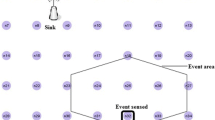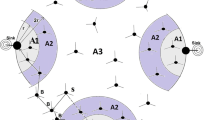Abstract
In a wireless sensor network, one of the most important constraints on sensor nodes is their power source, which is a battery. Sensor nodes carry a limited and generally irreplaceable battery. When providing a routing protocol for WSNs, it is necessary to take the energy constraint of sensor nodes into consideration. In this paper, a new routing algorithm based on a mobile sink is proposed. In the proposed algorithm, data is forwarded from the sensor nodes to the sink, which moves on four determined paths, by using a virtual cellular structure. In this algorithm when the sink moves from one cell to another, the routing in the network can be updated with minimum energy consumption and delay. The simulation results show that the proposed algorithm is more efficient than similar ones.












Similar content being viewed by others
References
Akyildiz, I. F., Su, W., Sankarasubramaniam, Y., & Cayirci, E. (2002). Wireless sensor networks: a survey. Computer Networks, 38(4), 393–422.
Fadel, E., Gungor, V. C., Nassef, L., Akkari, N., Malik, M. A., Almasri, S., et al. (2015). A survey on wireless sensor networks for smart grid. Computer Communications, 71, 22–33.
Khan, M. I., Gansterer, W. N., & Haring, G. (2013). Static vs. mobile sink: The influence of basic parameters on energy efficiency in wireless sensor networks. Computer Communications, 36(9), 965–978.
Yick, J., Mukherjee, B., & Ghosal, D. (2008). Wireless sensor network survey. Computer Networks, 52(12), 2292–2330.
Rault, T., Bouabdallah, A., & Challal, Y. (2014). Energy efficiency in wireless sensor networks: A top-down survey. Computer Networks, 67, 104–122.
Gu, Y., Ren, F., Ji, Y., & Li, J. (2016). The evolution of sink mobility management in wireless sensor networks: A survey. IEEE Communications Surveys & Tutorials, 18(1), 507–524.
Olariu, S., & Stojmenovic, I. (2006). Design guidelines for maximizing lifetime and avoiding energy holes in sensor networks with uniform distribution and uniform reporting. In INFOCOM 2006. 25th IEEE International Conference on Computer Communications. Proceedings (pp. 1-12). IEEE.
Shah, R. C., Roy, S., Jain, S., & Brunette, W. (2003). Data mules: Modeling and analysis of a three-tier architecture for sparse sensor networks. Ad Hoc Networks, 1(2), 215–233.
Curry, R. M., & Smith, J. C. (2016). A survey of optimization algorithms for wireless sensor network lifetime maximization. Computers & Industrial Engineering, 101, 145–166.
Luo, H., Ye, F., Cheng, J., Lu, S., & Zhang, L. (2005). TTDD: Two-tier data dissemination in large-scale wireless sensor networks. Wireless Networks, 11(1–2), 161–175.
Erman, A. T., Dilo, A., & Havinga, P. (2012). A virtual infrastructure based on honeycomb tessellation for data dissemination in multi-sink mobile wireless sensor networks. EURASIP Journal on Wireless Communications and Networking, 2012(1), 17.
Chen, X., & Xu, M. (2005). A geographical cellular-like architecture for wireless sensor networks. In International Conference on Mobile Ad-Hoc and Sensor Networks (pp. 249-258). Springer, Berlin, Heidelberg.
Tunca, C., Isik, S., Donmez, M. Y., & Ersoy, C. (2015). Ring routing: An energy-efficient routing protocol for wireless sensor networks with a mobile sink. IEEE Transactions on Mobile Computing, 14(9), 1947–1960.
Hamida, E. B., & Chelius, G. (2008). A line-based data dissemination protocol for wireless sensor networks with mobile sink. In Communications, 2008. ICC’08. IEEE International Conference on (pp. 2201-2205). IEEE.
Sharma, S., Puthal, D., Jena, S. K., Zomaya, A. Y., & Ranjan, R. (2017). Rendezvous based routing protocol for wireless sensor networks with mobile sink. The Journal of Supercomputing, 73(3), 1168–1188.
Abuarqoub, A., Hammoudeh, M., Adebisi, B., Jabbar, S., Bounceur, A., & Al-Bashar, H. (2017). Dynamic clustering and management of mobile wireless sensor networks. Computer Networks, 117, 62–75.
Saranya, V., Shankar, S., & Kanagachidambaresan, G. R. (2018). Energy efficient clustering scheme (EECS) for wireless sensor network with mobile sink. Wireless Personal Communications, 1-15.
Chen, T. S., Tsai, H. W., Chang, Y. H., & Chen, T. C. (2013). Geographic convergecast using mobile sink in wireless sensor networks. Computer Communications, 36(4), 445–458.
Salarian, H., Chin, K. W., & Naghdy, F. (2014). An energy-efficient mobile-sink path selection strategy for wireless sensor networks. IEEE Transactions on Vehicular Technology, 63(5), 2407–2419.
Zhu, C., Wu, S., Han, G., Shu, L., & Wu, H. (2015). A tree-cluster-based data-gathering algorithm for industrial WSNs with a mobile sink. IEEE Access, 3, 381–396.
Khan, A. W., Abdullah, A. H., Razzaque, M. A., & Bangash, J. I. (2015). VGDRA: a virtual grid-based dynamic routes adjustment scheme for mobile sink-based wireless sensor networks. IEEE Sensors Journal, 15(1), 526–534.
Wen, W., Zhao, S., Shang, C., & Chang, C. Y. (2018). EAPC: Energy-aware path construction for data collection using mobile sink in wireless sensor networks. IEEE Sensors Journal, 18(2), 890–901.
Arthi, K., & Lochana, A. S. R. (2018). Zone-based dual sub sink for network lifetime maximization in wireless sensor network. Cluster Computing, 1-11.
Heinzelman, W. B., Chandrakasan, A. P., & Balakrishnan, H. (2002). An application-specific protocol architecture for wireless microsensor networks. IEEE Transactions on Wireless Communications, 1(4), 660–670.
Author information
Authors and Affiliations
Corresponding author
Appendix A: Optimal number of the cells
Appendix A: Optimal number of the cells
In this section, we perform several experiments on the RBGM algorithm and show that 25 cells are a good number for the number of cells in the network. Here, in addition to the original version of the RBGM algorithm that contains 25 cells, we consider four versions RBGM_9, RBGM_16, BGM_36 and RBGM_49 of the RBGM algorithm, and the number of cells for each algorithm is given respectively as follows: 9 cells (three rows and three columns), 16 cells (four rows and four columns), 36 cells (six rows and six columns) and 49 cells (seven rows and seven cells). The default settings in Sect. 5 are also considered here, but with the difference that here we assume that the number of sensors in the network is fixed and is equal to 500 sensor nodes and the scenarios are considered as given in Table 4 which include areas of varying sizes from small to large.
The network lifetime, the number of received packets by the sink, and the average delay for the RBGM algorithm with different number of cells in the scenarios presented in Table 4 are measured. Comparison of these results shows the number of cells in the RBGM algorithm that leads to a better performance. Figure 13 shows the network lifetime for the two definitions, Fig. 14 shows the number of packets received by the sink and Fig. 15 shows the average delay of the RBGM algorithm for different number of cells in the scenarios presented in Table 4.
Comparison of RBGM with different number of cells in terms of network lifetime in the scenarios presented in Table 4. a Until the first node dies and b until 75% of the nodes die
Comparison of RBGM with different number of cells in terms of the number of data packets received by the sink in the scenarios presented in Table 4 until 75% of the nodes die
Comparison of RBGM with different number of cells in terms of delay in the scenarios presented in Table 4
As it is mentioned in Sect. 4.1, when the number of cells is higher, the number of cell headers increases. Since the selection of the cell headers and the tasks performed by them have a high energy consumption, when the number of cell headers is exceeded, the energy consumption in the network and in the nodes increases, and as a result, the nodes die earlier and the network lifetime is decreased. In addition, when the number of cell headers is higher, a data message needs to take more hops to reach the sink, and the more number of the hops, the more delay in the network. On the other hand, when the number of the cells is lower, there would exist more nodes in each cell and the “MSG_Share_prob” control message will be generated more, resulting in an increased energy consumption and delay. Moreover, in general, as network area increases, network lifetime decreases and network delay increases because the distance between the nodes and the number of hops increase. As these figures show, the RBGM_9 and RBGM_49 algorithms are less efficient; in fact, it can be said that these algorithms, due to the inadequate number of cells, in addition to shorter network lifetime, have a very high delay compared with the other algorithms. RBGM_16 and RBGM_36 have better performance than RBGM_9 and RBGM_49. In fact, the number of cells in them is closer to the optimal number. The RBGM algorithm with 25 cells has the best performance among these algorithms. According to this experiment, we can say that 25 cells is a good value for the number of the cells.
Rights and permissions
About this article
Cite this article
Yarinezhad, R., Hashemi, S.N. An efficient data dissemination model for wireless sensor networks. Wireless Netw 25, 3419–3439 (2019). https://doi.org/10.1007/s11276-018-1845-6
Published:
Issue Date:
DOI: https://doi.org/10.1007/s11276-018-1845-6







